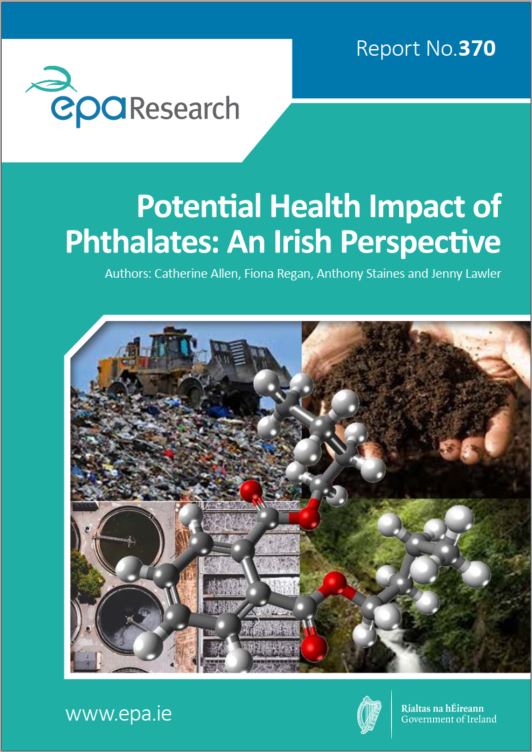Research 370: Potential Health Impact of Phthalates: An Irish Perspective
Authors: Catherine Allen, Fiona Regan, Anthony Staines and Jenny Lawler
Summary: Phthalates are plasticisers that are ubiquitous in the environment, have the potential to disrupt the endocrine system and are associated with a wide range of adverse health effects. This report identifies that all 11 phthalates studied are currently present in the Irish environment. The levels of human exposure indicate that there is no immediate risk to human health on a population-averaged basis.

Identifying Pressures
Phthalates are plasticisers that are ubiquitous in the environment, have the potential to disrupt the endocrine system and are associated with a wide range of adverse health effects. A study of phthalates was undertaken to:
- review the environmental sources and fate of phthalates in Ireland;
- develop robust methods for the analysis of phthalates in multiple environmental matrices;
- investigate the feasibility of applying wastewater-based epidemiology to assess exposure and health risk.
This report identifies that all 11 phthalates studied are currently present in the Irish environment. The levels of human exposure, as assessed via an analysis of phthalate metabolite levels in untreated wastewater, indicate that there is no immediate risk to human health on a population-averaged basis. Treated wastewater at all sites examined was of sufficient quality in terms of phthalate diester levels; however, phthalates are being retained in wastewater biosolids, and an analysis of land spreading practices and their impact on soil and agriculture should be assessed further.
Informing Policy
Seven phthalates (diethylhexyl phthalate – DEHP; dibutyl phthalate – DBP; benzyl butyl phthalate – BP; diisobutyl phthalate – DIBP; diisononyl phthalate; diisodecyl phthalate; di-n-octylphthalate – NOP) are currently restricted to certain manufacturing under Annex XVII to the Registration, Evaluation, Authorisation and Restriction of Chemicals (REACH) Regulation [Regulation (EC) No 1907/2006] and the Cosmetics Regulation [Regulation (EC) No 1223/2009]. The European Chemicals Agency has submitted a recommendation to REACH to amend the authorisation list (Annex XIV to REACH), identifying DEHP, DBP, BBP and DIBP as substances of very high concern because of their endocrine disrupting effects (in addition to their reprotoxicity), which may mean that previously exempted usages may require authorisation in the future. DHP was added to Annex XIV to Commission Regulation 2020/1711 of February 2020 because of its toxicity to reproduction. This project has demonstrated that DIBP is one of the most prevalent phthalates contained in the Irish environment. Dipentyl phthalate, a newer phthalate, has been found at some of the lowest concentrations in environmental samples in Ireland, yet it is more present in waste and sludge samples. Legislative restrictions help to prevent further introduction of new replacement phthalates into the environment.
Developing Solutions
A robust LC-MS method allowing background phthalate contamination to be reduced and controlled has been validated. This routine method can now be used to further monitor phthalates in the environment, and for any future compliance assessment of phthalate levels in consumer goods or in the monitoring of emissions levels.
Wastewater-based epidemiology has been developed as a novel means to assess the exposure risk of a population to endocrine disrupting compounds (EDCs). This method offers real-time, readily available and cost-effective data. Owing to the assumptions made during the process, it is best used as a first-step risk assessment or a method for prioritising EDCs. The exposure rates detected, when compared with the reference intakes described for phthalates, indicated that there is no existing risk to the Irish population from exposure to the 11 phthalates assessed in this work.
https://www.epa.ie/media/epa-2020/research/epa-funded-research/Twitter_370.jpg